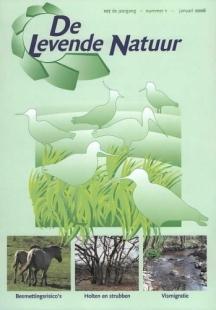De Levende Natuur nummer 1 van 2006 (English summary)
Afbeelding

Risks of contamination between free living and domestic ungulates
Groot Bruinderink, G.W.T.A. & D.R. Lammertsma
Over the past 30 years in natural areas in North-western Europe, domestic ungulates have been introduced. Ecological networks have been planned for free living large mammal species like Red deer and Wild boar. This raises the debate on risks of mutual contamination between domestic stock and free living ungulates. We argue that the debate can be restricted to two ‘highly contagious diseases’ Classical Swine Fever (CSF) and Food and Mouth Disease (FMD). Until now evidence of mutual contamination of these diseases between domestic stock and free living ungulates could not be established. Other vectors, like transports of contaminated cattle, have been proved to be responsible for the spread after recent outbreaks.
Holten and strubben around the Drentse Aa river
Smeenge, H.
The landscape around the Drentse Aa is famous for its species rich meadows and attractive surroundings. The present paper focussed on the forest use that occurred around the villages between 1400 AD and present. Two types of forest structures can be defined: holten (high forests) are found around the arable fields (essen); they were used for timber, i.e. wood cutting, ship building and mill axes. Strubben (shrub forests) were more open in structure due to heavy sheep grazing and more common rights of land use compared to the more restricted holten. The current management of non intervention, forest succession (shrub encroachment) and eutrophication (bramble encroachment) led to a leveling out of the two types of forest structure and resulted in a loss of different ecological niches. The reintroduction of traditional land use forms such as shrub- and sod removal plus sheep grazing in ‘strubben’ and litter removal or the reintroduction of domesticated pigs in ‘holten’ create more diverse structures and thereby a reinforcement of ecological potentials. Interdisciplinary cooperation between the different parties (archaeologists, palaeo-botanists, historians and ecologists) is a powerful tool to define the potential areas and integrate them in a management plan. The financial feasibility can increase by selling fire wood or rent parts of the area for sheep grazing etc.; this increases the involvement of the local communities as well.
A new impulse for wetland restoration? The approach in the provinces Groningen and northern part of Drenthe as an example
Vegter, U., L. Smilde, R. van Veen & N.F. Altena
Restoration of desiccated, wet ecosystems in The Netherlands appeared to be less effective than required. Until now 3% of these nature reserves has been restored, where in 2000 restoration of 25% of the area had to be accomplished. In the northern part of the country (provinces of Groningen and the northern part of Drenthe) a new approach has to increase the effectiveness, leading to restoration of 400 hectares dehydrated nature reserve each year. Important is the integrated, area specific system-approach in which elements of the new water policy (f.i. European framework directive) are included. Furthermore better and more intense communication between the organisations involved (provinces, water boards, nature organisations) is a key factor for success. In some areas the approach is already succesfull. We hope this article can be of inspiration and contributes to a more effective wetland restoration.
Development of phanerogam flora in Schepping, a new nature area in Drenthe
Arnolds, E.J.M.
Schepping is a private nature reserve (5,6 ha), situated on dry Pleistocene sand. In 1991 new habitats were developed in a former arable field (2,8 ha) by removal of top soil and digging of ponds. Until 2004 298 native plant species were recorded. Most species originate from the former arable field or populations within a distance of 200 m, but 61 species had nearest populations between 200 and 1000 m and 13 species further than 1 km. Among the species are 34 target species of heathlands and poor grasslands, 20 of them with nearest populations over 200 m away (table 1). Accidental long term dispersal is considered an important factor in colonisation of new habitats. The numbers of plant species and target species are high compared to similar newly developed habitats elsewhere in Northeastern Netherlands. This is mainly explained by the intensive research and the large variation in environmental conditions, good habitat quality and optimal management.

